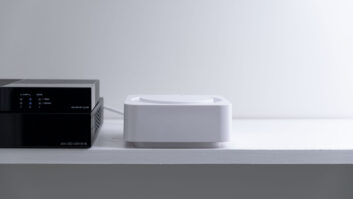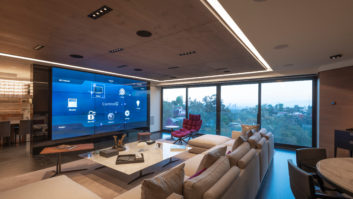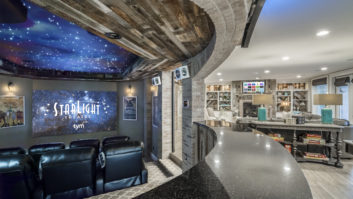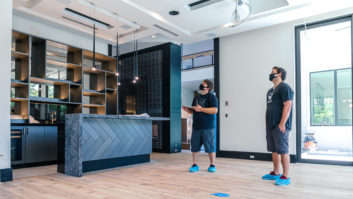While some companies service both the high-end custom and production home markets, the similarities between these two categories are few and far between. The base technology, in most cases, may be the same, but the customer, the scope of the job and its duration, and how the project must be executed is entirely different, as is the relationship that the integration firm shares with the homebuilder.
Sean Fields, owner and president of AVE-Audio/Video Entertainment Inc., in Laguna Niguel, California, emphasizes that an integrators reputation is extremely important, and references from both colleagues and superintendents are helpful. Builders look for companies that are fast, efficient, professional, clean, legal, and companies with a low experience modification rate, he noted, referring to the toll of injuries that have occurred within your company and how serious they were. Also, the very highest level of customer service is essential.
Dennis Sage, president of Dennis Sage Home Entertainment in Phoenix, Arizona, notes that its not really the homebuilders that are constructing the houses; the subcontractors are. As such, homebuilders seek integrators that take responsibility for their portion of the project without causing headaches. Once we negotiate with them, sign the contract, and understand what is expected of us for the job, they hand it off and we take responsibility for everything, he said.
Because production homes are just thatmass-produced producthome integrators are easily able to fall into a routine that maximizes efficiency. With production projects, we do the same thing over and over again. My team knows exactly what theyre going to do when they get to the job site, they know exactly how long its going to take, and we know exactly how much we are going to be paid for it, Sage said. At Dennis Sage Home Entertainment, which started out conducting production projects before branching out into custom, a team of 45 installers handles both production jobs as well as custom projects, depending on the workflow.
About 60 percent of installations from Jacksonville, Floridas Atlantic Home Technologies are in production homes. Company president John Prince, however, is quick to note that not all production homes are created equal. There are two or three different levels of production homes, he explained. We tend to stay away from the entry-level ($200,000-$300,000) track homes, because those builders are trying to keep their base cost as low as possible. They only go after structured wiring when theyre dragged there kicking and screaming.
Prince, whose company grosses between $4- and $5-million/year with 35 full-time employees, finds the key to success in the production market is establishing his installation firm as a one-stop shop for low-voltage technology. The more low-voltage SKUs that you can do the better you are in the eyes of the builder, he added. For instance, theyd like to do security, structured wiring, central vac, distributed audio, home theater, all from one company. Its fewer subs for them to manage, fewer POs to cut, fewer checks to write, and fewer calls to make when they schedule a rough or a trim.
Michael Creeden, president of M+R Digital Innovations, in Spring Grove, Illinois, also believes that working with production home builders requires a different mindset in terms of project flexibility. Most guys dont understand how to speak to builders, he said. You cannot go in to a builder and say, I only want to do the $50,000 jobs. Theyll laugh at you. They dont understand that. Theyre offended by that actually. I tell them, Ill do your $100,000 client and Ill do your $1,000 client.
Its an approach, Creeden noted, that requires customization on the high-end, but packaged solutions on the low-end. Obviously we have our issues with packages in our industry right now; you either love them or hate them, he added. My biggest endeavor this year is to formalize our packages and to start using them as a qualifying tool. If you come in and arent qualified as high-end, well heres your package. And were not going to spend the same kind of time on that customer, which ultimately kills you.
While some may argue the production market isnt profitable, Sage maintains that if an integration firm has solid processes in place, the revenues can be significant. The trick, he says, is getting it right the first time. We price this in a way that it is profitable for us to do it if we do it right once, he explained. If we go out to do a surround sound pre-wire, and we do it right the first time, there is profit in that job. If a mistake is made and a technician must be sent back to the site to fix it, the project is no longer profitable; its break-even.
Sage concedes, however, that margins are growing increasingly thin as builders engage national companies that price their systems at a loss to gain revenues with add-ons, such as security monitoring. In some cases, he, too, is forced to do the same to win additional business from the homeowner. Depending on the builder we are working with, we will decide, as a team, whether or not we want to match this price and the job at a loss or at the break-even point in order to get the rest of what this customer wants, he said.
The base package that Sage sells to the builder may be reduced, but any additional televisions or security features are sold to the homeowner at the regular price. The builder doesnt care, as long as they have their cut and as long as you do the paperwork in the right amount of time, they will include it in the mortgage and it becomes very profitable.
Getting to the homeowner, then, is paramount, and this largely depends on the agreement the builder has drawn up with the integrator. We educate our homebuilders in the beginning to refer the homebuyer to us as soon as they are interested in multiple phone lines or HD, explained John Goldenne, president of Digital Home Technologies in Palatine, Illinois.
Dennis Home Entertainment, for example, arranges to be the de facto integrator for production homebuyers that wish to expand their systems beyond the base package that is included in the price of the house; most of the builders Sage works with, he explains, will not allow another subcontractor to take the job on. The reason why is that the builder makes money on us. If we sell a speaker for $200 to the customer, the builder makes 20 percent on that, and we add the 20 percent in the sale.
For those considering the production home market, a solid back-office infrastructure is necessary to help adjust to the builders often rapid-changing needs. Each builder differs slightly in terms of billing, scheduling, and communications, and integrators must roll with the punches. If a company is able to turn on a dime, it has the right number of people and the systems in place, the production can work well, Sage said, underlining that the need for flexibility comes with the territory. They may schedule poorly and will call you on a Tuesday, saying that they need you Wednesday. If you are too busy to get out there on Wednesday, it can become an ugly situation. You really need to be able to turn on a dime to meet the builders requirements. To achieve this, production home integrators cannot cut corners when it comes to hiring employees.
Fields advises company owners that are considering the track home market to conduct some in-depth soul-searching. You have to ask yourself some hard questions, he said. Can your company design, install, bill, and service 20 to 50 installation projects on a weekly basis? Have you established the proper departments, such as wiring, pre-wiring, and equipment installation? Is your back office running like a well-oiled machine, and do you have a human resources professional in place? Have you instilled safety-consciousness in your employees? If you have these things, you have 50 percent of what you need, Fields said. This is a very difficult choice and so many have tried and gone out of business from cash flow problems to just getting plain buried. You need a good business plan and start with some small projects.
In view of softening markets, the production home business, Fields believes, has reached a divide: one portion of the category is buying and selling based on price only, while the other favors value. He advises integrators to target the latter. We are already seeing examples of builders pre-plotting homes with upgraded home entertainment wiring, speakers, and in a few cases, integrated flat-panel TVs, he observed. This is a critical time for integrators. Buyers want our systems; we sell the fun stuff. This is the time to make the push. If we do this as an industry I foresee our business taking off like gangbusters.
Sage, too, remains positive, largely because homebuilders, in an effort to remain competitive, are warming up to what the low-voltage community can offer. Many of these builders are getting very creative about what they are putting into the homes, he said. The infrastructure for a lot of these jobs is becoming much more intense in order to prepare for the future, and to show to those homebuyers that are looking at several different builders, that they understand technology. The nice part about it is that our industry is becoming really important in terms of being able to tie all of these systems together, and builders are starting to catch on. They are starting to include more things as standards into the home, which gives us the right to talk to these clients and add more.
Carolyn Heinze is a freelance writer/editor.







